NRSG366 - Clinical Reasoning Cycle: Peter's Chronic Condition Case
VerifiedAdded on 2023/04/22
|7
|3134
|142
Case Study
AI Summary
This case study utilizes the Levett Jones clinical reasoning cycle to analyze the case of Peter, a 52-year-old obese man with type II diabetes, hypertension, and depression, recently discharged to community healthcare. The study identifies key nursing priorities, focusing on Peter's immediate needs for wellbeing. The clinical reasoning cycle aids in evaluating Peter's medical and social history, highlighting the interconnectedness of his conditions. Obesity and depression are identified as major nursing issues, with goals including BMI reduction, improved motivation, and regular monitoring of vital signs. Nursing interventions involve allied healthcare support, exercise-based therapy, dietary plans, and community engagement. The study emphasizes the importance of regular evaluation to assess intervention effectiveness and modify strategies as needed, ensuring a positive health outcome for Peter. The case underscores the value of the clinical reasoning cycle in providing a structured approach to complex patient care.
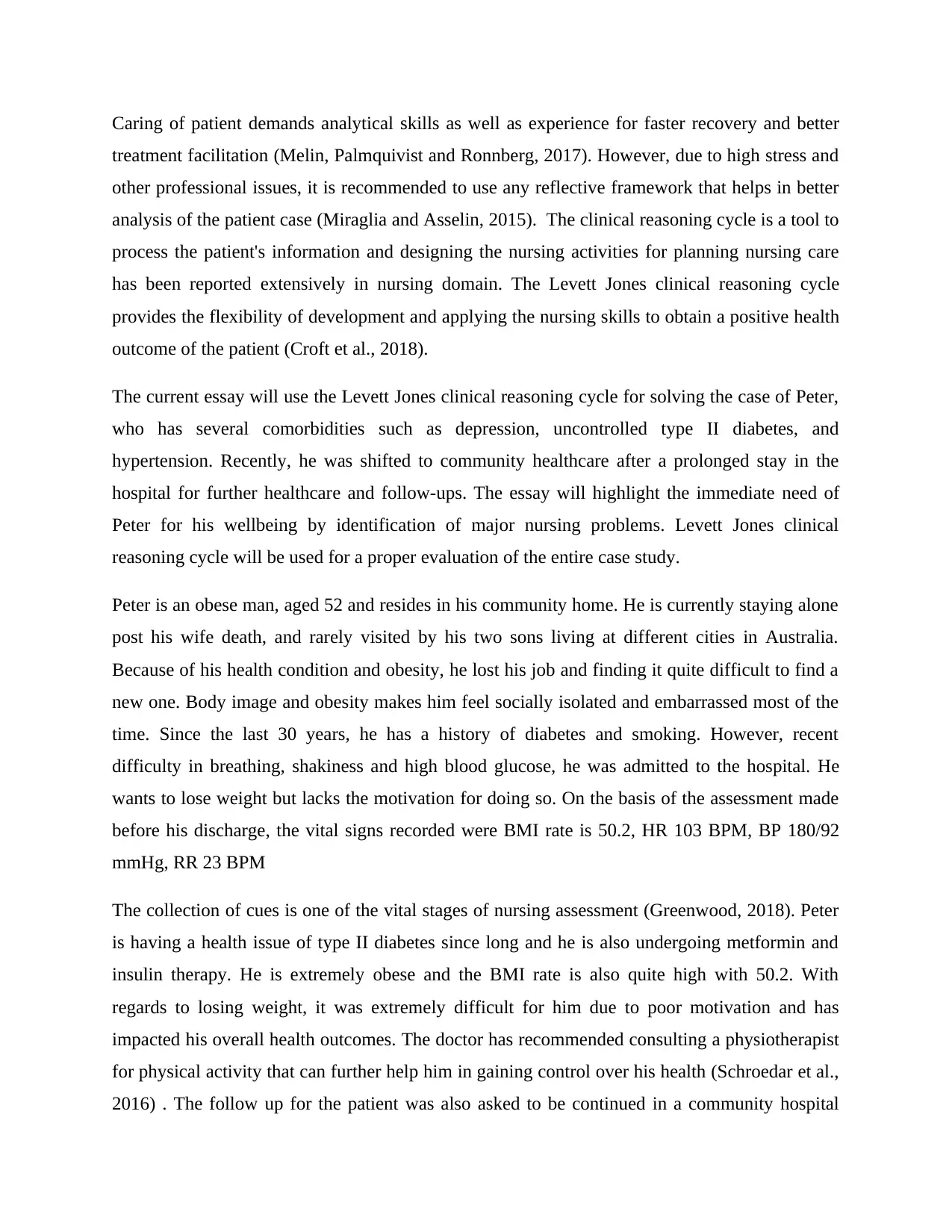
Caring of patient demands analytical skills as well as experience for faster recovery and better
treatment facilitation (Melin, Palmquivist and Ronnberg, 2017). However, due to high stress and
other professional issues, it is recommended to use any reflective framework that helps in better
analysis of the patient case (Miraglia and Asselin, 2015). The clinical reasoning cycle is a tool to
process the patient's information and designing the nursing activities for planning nursing care
has been reported extensively in nursing domain. The Levett Jones clinical reasoning cycle
provides the flexibility of development and applying the nursing skills to obtain a positive health
outcome of the patient (Croft et al., 2018).
The current essay will use the Levett Jones clinical reasoning cycle for solving the case of Peter,
who has several comorbidities such as depression, uncontrolled type II diabetes, and
hypertension. Recently, he was shifted to community healthcare after a prolonged stay in the
hospital for further healthcare and follow-ups. The essay will highlight the immediate need of
Peter for his wellbeing by identification of major nursing problems. Levett Jones clinical
reasoning cycle will be used for a proper evaluation of the entire case study.
Peter is an obese man, aged 52 and resides in his community home. He is currently staying alone
post his wife death, and rarely visited by his two sons living at different cities in Australia.
Because of his health condition and obesity, he lost his job and finding it quite difficult to find a
new one. Body image and obesity makes him feel socially isolated and embarrassed most of the
time. Since the last 30 years, he has a history of diabetes and smoking. However, recent
difficulty in breathing, shakiness and high blood glucose, he was admitted to the hospital. He
wants to lose weight but lacks the motivation for doing so. On the basis of the assessment made
before his discharge, the vital signs recorded were BMI rate is 50.2, HR 103 BPM, BP 180/92
mmHg, RR 23 BPM
The collection of cues is one of the vital stages of nursing assessment (Greenwood, 2018). Peter
is having a health issue of type II diabetes since long and he is also undergoing metformin and
insulin therapy. He is extremely obese and the BMI rate is also quite high with 50.2. With
regards to losing weight, it was extremely difficult for him due to poor motivation and has
impacted his overall health outcomes. The doctor has recommended consulting a physiotherapist
for physical activity that can further help him in gaining control over his health (Schroedar et al.,
2016) . The follow up for the patient was also asked to be continued in a community hospital
treatment facilitation (Melin, Palmquivist and Ronnberg, 2017). However, due to high stress and
other professional issues, it is recommended to use any reflective framework that helps in better
analysis of the patient case (Miraglia and Asselin, 2015). The clinical reasoning cycle is a tool to
process the patient's information and designing the nursing activities for planning nursing care
has been reported extensively in nursing domain. The Levett Jones clinical reasoning cycle
provides the flexibility of development and applying the nursing skills to obtain a positive health
outcome of the patient (Croft et al., 2018).
The current essay will use the Levett Jones clinical reasoning cycle for solving the case of Peter,
who has several comorbidities such as depression, uncontrolled type II diabetes, and
hypertension. Recently, he was shifted to community healthcare after a prolonged stay in the
hospital for further healthcare and follow-ups. The essay will highlight the immediate need of
Peter for his wellbeing by identification of major nursing problems. Levett Jones clinical
reasoning cycle will be used for a proper evaluation of the entire case study.
Peter is an obese man, aged 52 and resides in his community home. He is currently staying alone
post his wife death, and rarely visited by his two sons living at different cities in Australia.
Because of his health condition and obesity, he lost his job and finding it quite difficult to find a
new one. Body image and obesity makes him feel socially isolated and embarrassed most of the
time. Since the last 30 years, he has a history of diabetes and smoking. However, recent
difficulty in breathing, shakiness and high blood glucose, he was admitted to the hospital. He
wants to lose weight but lacks the motivation for doing so. On the basis of the assessment made
before his discharge, the vital signs recorded were BMI rate is 50.2, HR 103 BPM, BP 180/92
mmHg, RR 23 BPM
The collection of cues is one of the vital stages of nursing assessment (Greenwood, 2018). Peter
is having a health issue of type II diabetes since long and he is also undergoing metformin and
insulin therapy. He is extremely obese and the BMI rate is also quite high with 50.2. With
regards to losing weight, it was extremely difficult for him due to poor motivation and has
impacted his overall health outcomes. The doctor has recommended consulting a physiotherapist
for physical activity that can further help him in gaining control over his health (Schroedar et al.,
2016) . The follow up for the patient was also asked to be continued in a community hospital
Paraphrase This Document
Need a fresh take? Get an instant paraphrase of this document with our AI Paraphraser
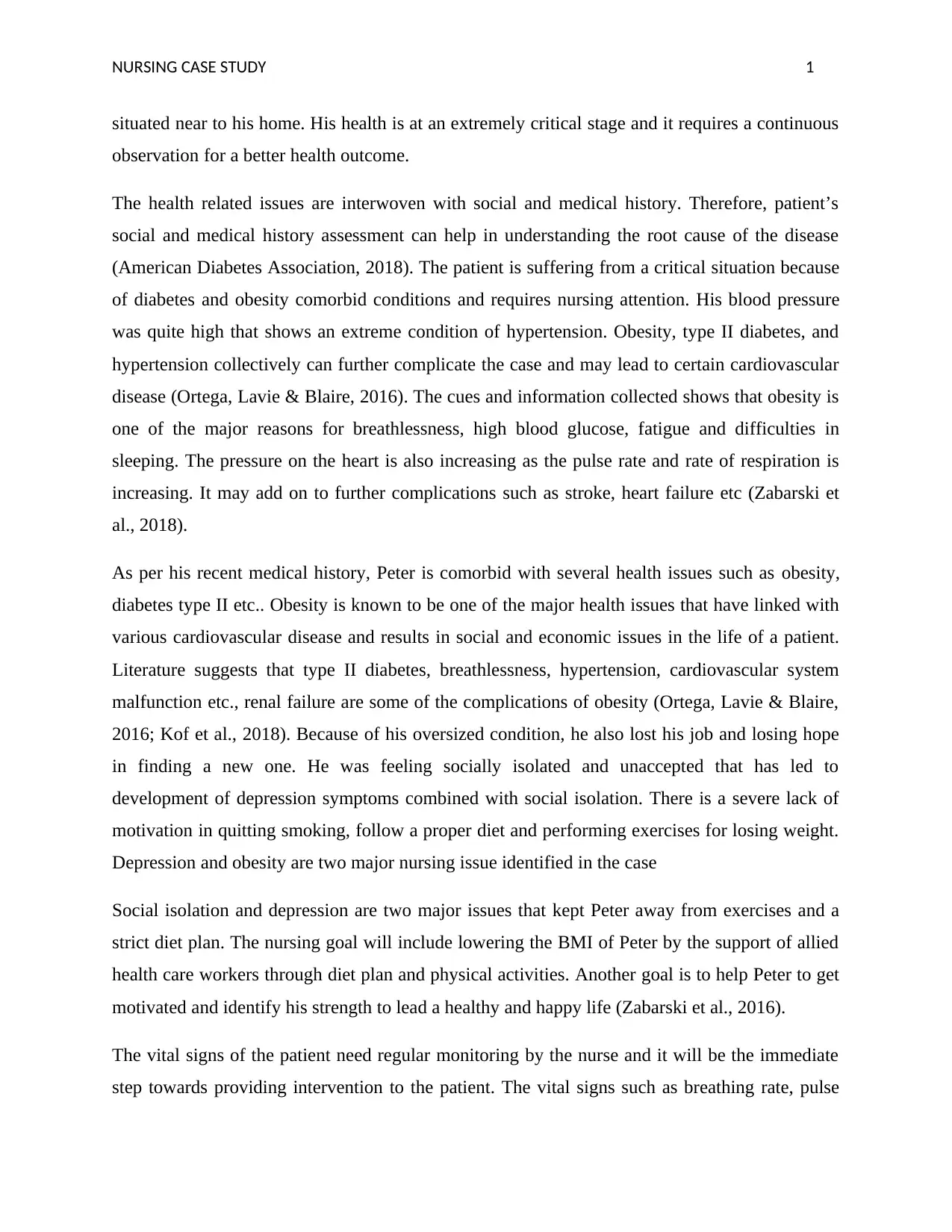
NURSING CASE STUDY 1
situated near to his home. His health is at an extremely critical stage and it requires a continuous
observation for a better health outcome.
The health related issues are interwoven with social and medical history. Therefore, patient’s
social and medical history assessment can help in understanding the root cause of the disease
(American Diabetes Association, 2018). The patient is suffering from a critical situation because
of diabetes and obesity comorbid conditions and requires nursing attention. His blood pressure
was quite high that shows an extreme condition of hypertension. Obesity, type II diabetes, and
hypertension collectively can further complicate the case and may lead to certain cardiovascular
disease (Ortega, Lavie & Blaire, 2016). The cues and information collected shows that obesity is
one of the major reasons for breathlessness, high blood glucose, fatigue and difficulties in
sleeping. The pressure on the heart is also increasing as the pulse rate and rate of respiration is
increasing. It may add on to further complications such as stroke, heart failure etc (Zabarski et
al., 2018).
As per his recent medical history, Peter is comorbid with several health issues such as obesity,
diabetes type II etc.. Obesity is known to be one of the major health issues that have linked with
various cardiovascular disease and results in social and economic issues in the life of a patient.
Literature suggests that type II diabetes, breathlessness, hypertension, cardiovascular system
malfunction etc., renal failure are some of the complications of obesity (Ortega, Lavie & Blaire,
2016; Kof et al., 2018). Because of his oversized condition, he also lost his job and losing hope
in finding a new one. He was feeling socially isolated and unaccepted that has led to
development of depression symptoms combined with social isolation. There is a severe lack of
motivation in quitting smoking, follow a proper diet and performing exercises for losing weight.
Depression and obesity are two major nursing issue identified in the case
Social isolation and depression are two major issues that kept Peter away from exercises and a
strict diet plan. The nursing goal will include lowering the BMI of Peter by the support of allied
health care workers through diet plan and physical activities. Another goal is to help Peter to get
motivated and identify his strength to lead a healthy and happy life (Zabarski et al., 2016).
The vital signs of the patient need regular monitoring by the nurse and it will be the immediate
step towards providing intervention to the patient. The vital signs such as breathing rate, pulse
situated near to his home. His health is at an extremely critical stage and it requires a continuous
observation for a better health outcome.
The health related issues are interwoven with social and medical history. Therefore, patient’s
social and medical history assessment can help in understanding the root cause of the disease
(American Diabetes Association, 2018). The patient is suffering from a critical situation because
of diabetes and obesity comorbid conditions and requires nursing attention. His blood pressure
was quite high that shows an extreme condition of hypertension. Obesity, type II diabetes, and
hypertension collectively can further complicate the case and may lead to certain cardiovascular
disease (Ortega, Lavie & Blaire, 2016). The cues and information collected shows that obesity is
one of the major reasons for breathlessness, high blood glucose, fatigue and difficulties in
sleeping. The pressure on the heart is also increasing as the pulse rate and rate of respiration is
increasing. It may add on to further complications such as stroke, heart failure etc (Zabarski et
al., 2018).
As per his recent medical history, Peter is comorbid with several health issues such as obesity,
diabetes type II etc.. Obesity is known to be one of the major health issues that have linked with
various cardiovascular disease and results in social and economic issues in the life of a patient.
Literature suggests that type II diabetes, breathlessness, hypertension, cardiovascular system
malfunction etc., renal failure are some of the complications of obesity (Ortega, Lavie & Blaire,
2016; Kof et al., 2018). Because of his oversized condition, he also lost his job and losing hope
in finding a new one. He was feeling socially isolated and unaccepted that has led to
development of depression symptoms combined with social isolation. There is a severe lack of
motivation in quitting smoking, follow a proper diet and performing exercises for losing weight.
Depression and obesity are two major nursing issue identified in the case
Social isolation and depression are two major issues that kept Peter away from exercises and a
strict diet plan. The nursing goal will include lowering the BMI of Peter by the support of allied
health care workers through diet plan and physical activities. Another goal is to help Peter to get
motivated and identify his strength to lead a healthy and happy life (Zabarski et al., 2016).
The vital signs of the patient need regular monitoring by the nurse and it will be the immediate
step towards providing intervention to the patient. The vital signs such as breathing rate, pulse
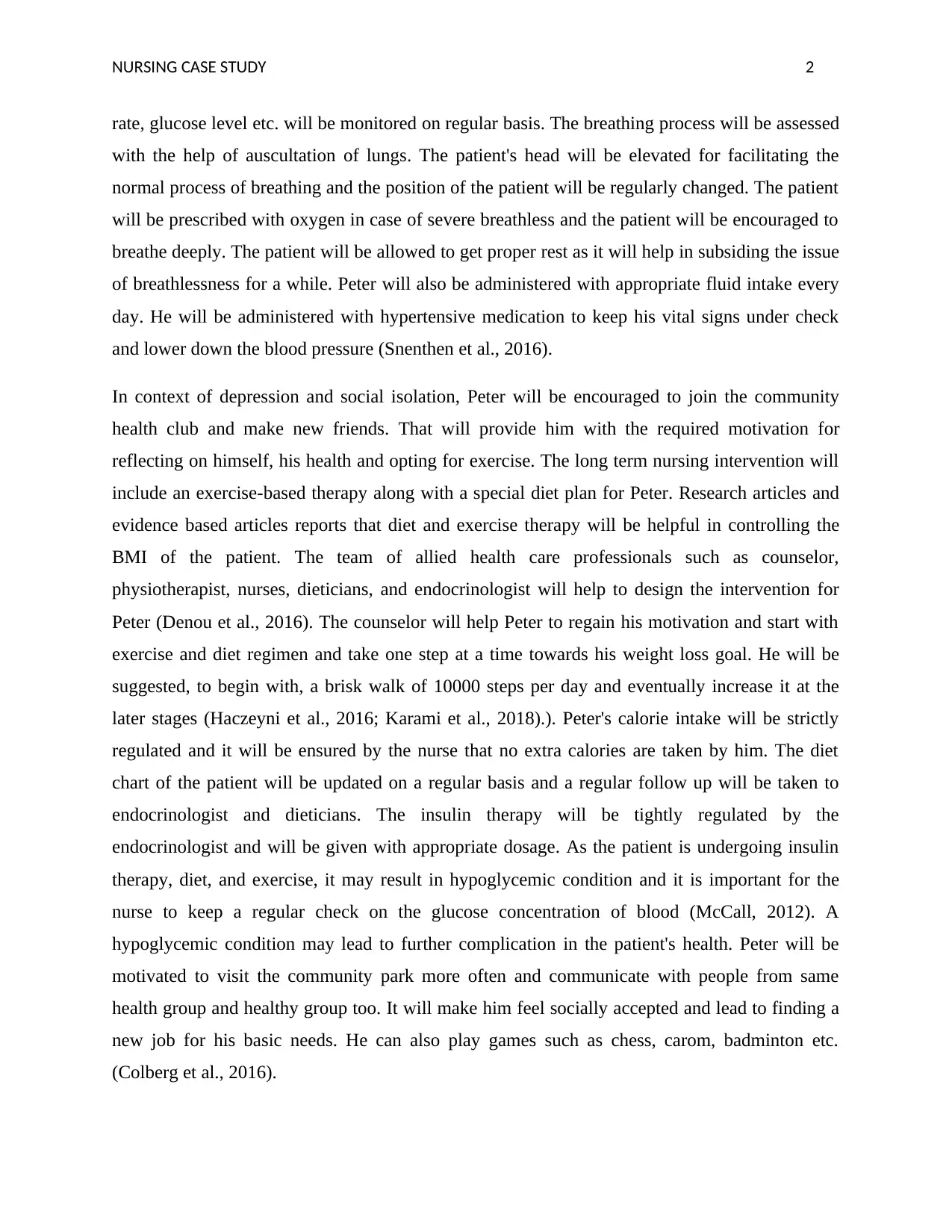
NURSING CASE STUDY 2
rate, glucose level etc. will be monitored on regular basis. The breathing process will be assessed
with the help of auscultation of lungs. The patient's head will be elevated for facilitating the
normal process of breathing and the position of the patient will be regularly changed. The patient
will be prescribed with oxygen in case of severe breathless and the patient will be encouraged to
breathe deeply. The patient will be allowed to get proper rest as it will help in subsiding the issue
of breathlessness for a while. Peter will also be administered with appropriate fluid intake every
day. He will be administered with hypertensive medication to keep his vital signs under check
and lower down the blood pressure (Snenthen et al., 2016).
In context of depression and social isolation, Peter will be encouraged to join the community
health club and make new friends. That will provide him with the required motivation for
reflecting on himself, his health and opting for exercise. The long term nursing intervention will
include an exercise-based therapy along with a special diet plan for Peter. Research articles and
evidence based articles reports that diet and exercise therapy will be helpful in controlling the
BMI of the patient. The team of allied health care professionals such as counselor,
physiotherapist, nurses, dieticians, and endocrinologist will help to design the intervention for
Peter (Denou et al., 2016). The counselor will help Peter to regain his motivation and start with
exercise and diet regimen and take one step at a time towards his weight loss goal. He will be
suggested, to begin with, a brisk walk of 10000 steps per day and eventually increase it at the
later stages (Haczeyni et al., 2016; Karami et al., 2018).). Peter's calorie intake will be strictly
regulated and it will be ensured by the nurse that no extra calories are taken by him. The diet
chart of the patient will be updated on a regular basis and a regular follow up will be taken to
endocrinologist and dieticians. The insulin therapy will be tightly regulated by the
endocrinologist and will be given with appropriate dosage. As the patient is undergoing insulin
therapy, diet, and exercise, it may result in hypoglycemic condition and it is important for the
nurse to keep a regular check on the glucose concentration of blood (McCall, 2012). A
hypoglycemic condition may lead to further complication in the patient's health. Peter will be
motivated to visit the community park more often and communicate with people from same
health group and healthy group too. It will make him feel socially accepted and lead to finding a
new job for his basic needs. He can also play games such as chess, carom, badminton etc.
(Colberg et al., 2016).
rate, glucose level etc. will be monitored on regular basis. The breathing process will be assessed
with the help of auscultation of lungs. The patient's head will be elevated for facilitating the
normal process of breathing and the position of the patient will be regularly changed. The patient
will be prescribed with oxygen in case of severe breathless and the patient will be encouraged to
breathe deeply. The patient will be allowed to get proper rest as it will help in subsiding the issue
of breathlessness for a while. Peter will also be administered with appropriate fluid intake every
day. He will be administered with hypertensive medication to keep his vital signs under check
and lower down the blood pressure (Snenthen et al., 2016).
In context of depression and social isolation, Peter will be encouraged to join the community
health club and make new friends. That will provide him with the required motivation for
reflecting on himself, his health and opting for exercise. The long term nursing intervention will
include an exercise-based therapy along with a special diet plan for Peter. Research articles and
evidence based articles reports that diet and exercise therapy will be helpful in controlling the
BMI of the patient. The team of allied health care professionals such as counselor,
physiotherapist, nurses, dieticians, and endocrinologist will help to design the intervention for
Peter (Denou et al., 2016). The counselor will help Peter to regain his motivation and start with
exercise and diet regimen and take one step at a time towards his weight loss goal. He will be
suggested, to begin with, a brisk walk of 10000 steps per day and eventually increase it at the
later stages (Haczeyni et al., 2016; Karami et al., 2018).). Peter's calorie intake will be strictly
regulated and it will be ensured by the nurse that no extra calories are taken by him. The diet
chart of the patient will be updated on a regular basis and a regular follow up will be taken to
endocrinologist and dieticians. The insulin therapy will be tightly regulated by the
endocrinologist and will be given with appropriate dosage. As the patient is undergoing insulin
therapy, diet, and exercise, it may result in hypoglycemic condition and it is important for the
nurse to keep a regular check on the glucose concentration of blood (McCall, 2012). A
hypoglycemic condition may lead to further complication in the patient's health. Peter will be
motivated to visit the community park more often and communicate with people from same
health group and healthy group too. It will make him feel socially accepted and lead to finding a
new job for his basic needs. He can also play games such as chess, carom, badminton etc.
(Colberg et al., 2016).
⊘ This is a preview!⊘
Do you want full access?
Subscribe today to unlock all pages.

Trusted by 1+ million students worldwide
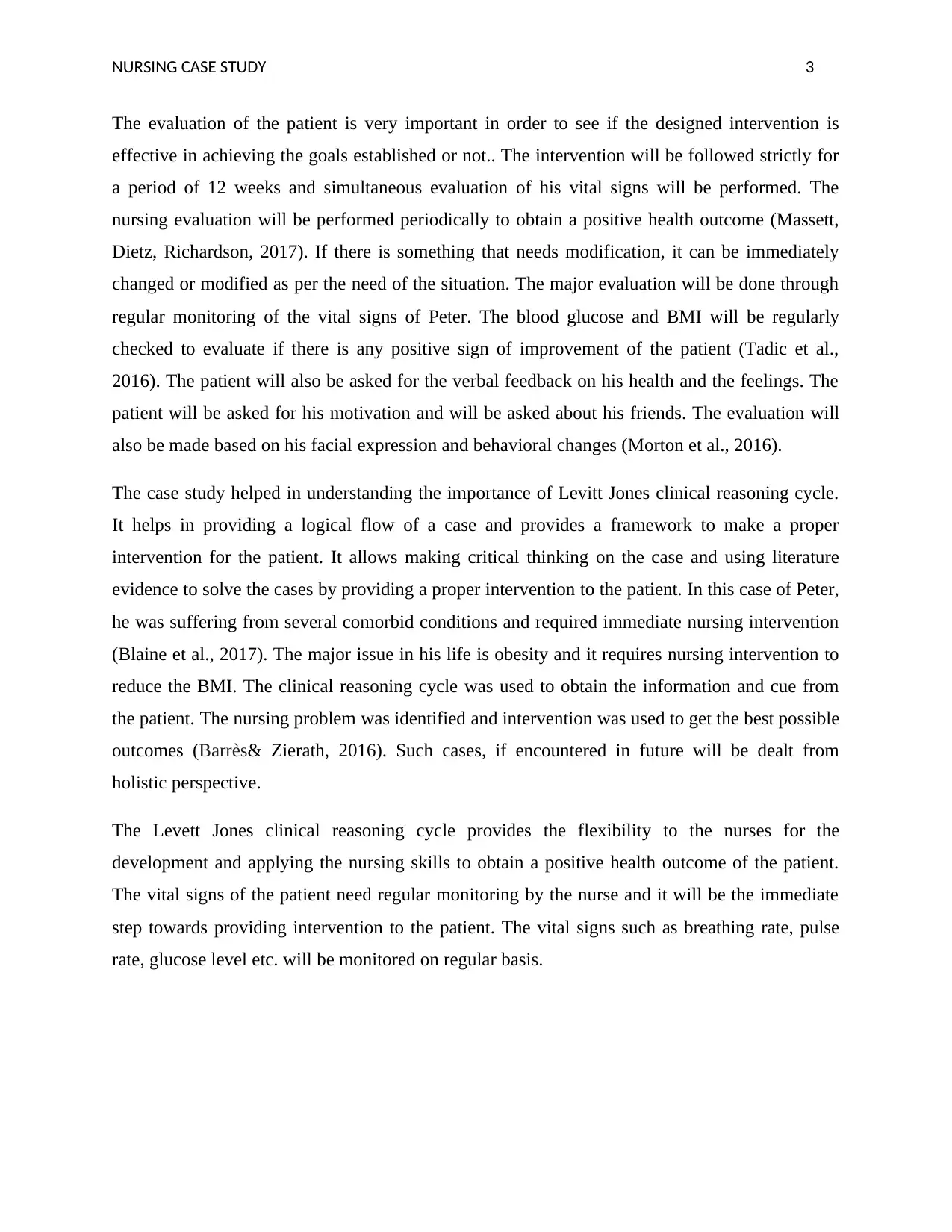
NURSING CASE STUDY 3
The evaluation of the patient is very important in order to see if the designed intervention is
effective in achieving the goals established or not.. The intervention will be followed strictly for
a period of 12 weeks and simultaneous evaluation of his vital signs will be performed. The
nursing evaluation will be performed periodically to obtain a positive health outcome (Massett,
Dietz, Richardson, 2017). If there is something that needs modification, it can be immediately
changed or modified as per the need of the situation. The major evaluation will be done through
regular monitoring of the vital signs of Peter. The blood glucose and BMI will be regularly
checked to evaluate if there is any positive sign of improvement of the patient (Tadic et al.,
2016). The patient will also be asked for the verbal feedback on his health and the feelings. The
patient will be asked for his motivation and will be asked about his friends. The evaluation will
also be made based on his facial expression and behavioral changes (Morton et al., 2016).
The case study helped in understanding the importance of Levitt Jones clinical reasoning cycle.
It helps in providing a logical flow of a case and provides a framework to make a proper
intervention for the patient. It allows making critical thinking on the case and using literature
evidence to solve the cases by providing a proper intervention to the patient. In this case of Peter,
he was suffering from several comorbid conditions and required immediate nursing intervention
(Blaine et al., 2017). The major issue in his life is obesity and it requires nursing intervention to
reduce the BMI. The clinical reasoning cycle was used to obtain the information and cue from
the patient. The nursing problem was identified and intervention was used to get the best possible
outcomes (Barrès& Zierath, 2016). Such cases, if encountered in future will be dealt from
holistic perspective.
The Levett Jones clinical reasoning cycle provides the flexibility to the nurses for the
development and applying the nursing skills to obtain a positive health outcome of the patient.
The vital signs of the patient need regular monitoring by the nurse and it will be the immediate
step towards providing intervention to the patient. The vital signs such as breathing rate, pulse
rate, glucose level etc. will be monitored on regular basis.
The evaluation of the patient is very important in order to see if the designed intervention is
effective in achieving the goals established or not.. The intervention will be followed strictly for
a period of 12 weeks and simultaneous evaluation of his vital signs will be performed. The
nursing evaluation will be performed periodically to obtain a positive health outcome (Massett,
Dietz, Richardson, 2017). If there is something that needs modification, it can be immediately
changed or modified as per the need of the situation. The major evaluation will be done through
regular monitoring of the vital signs of Peter. The blood glucose and BMI will be regularly
checked to evaluate if there is any positive sign of improvement of the patient (Tadic et al.,
2016). The patient will also be asked for the verbal feedback on his health and the feelings. The
patient will be asked for his motivation and will be asked about his friends. The evaluation will
also be made based on his facial expression and behavioral changes (Morton et al., 2016).
The case study helped in understanding the importance of Levitt Jones clinical reasoning cycle.
It helps in providing a logical flow of a case and provides a framework to make a proper
intervention for the patient. It allows making critical thinking on the case and using literature
evidence to solve the cases by providing a proper intervention to the patient. In this case of Peter,
he was suffering from several comorbid conditions and required immediate nursing intervention
(Blaine et al., 2017). The major issue in his life is obesity and it requires nursing intervention to
reduce the BMI. The clinical reasoning cycle was used to obtain the information and cue from
the patient. The nursing problem was identified and intervention was used to get the best possible
outcomes (Barrès& Zierath, 2016). Such cases, if encountered in future will be dealt from
holistic perspective.
The Levett Jones clinical reasoning cycle provides the flexibility to the nurses for the
development and applying the nursing skills to obtain a positive health outcome of the patient.
The vital signs of the patient need regular monitoring by the nurse and it will be the immediate
step towards providing intervention to the patient. The vital signs such as breathing rate, pulse
rate, glucose level etc. will be monitored on regular basis.
Paraphrase This Document
Need a fresh take? Get an instant paraphrase of this document with our AI Paraphraser
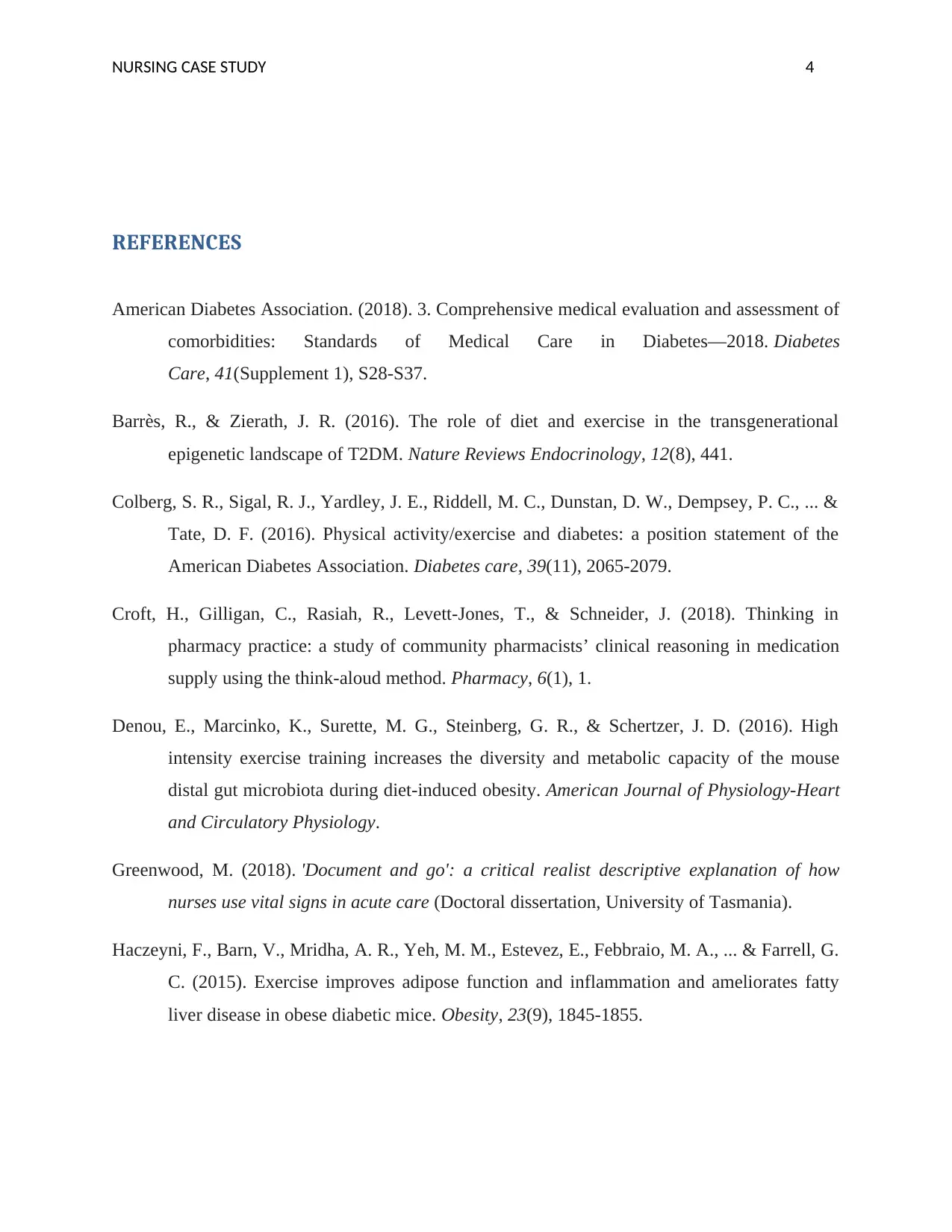
NURSING CASE STUDY 4
REFERENCES
American Diabetes Association. (2018). 3. Comprehensive medical evaluation and assessment of
comorbidities: Standards of Medical Care in Diabetes—2018. Diabetes
Care, 41(Supplement 1), S28-S37.
Barrès, R., & Zierath, J. R. (2016). The role of diet and exercise in the transgenerational
epigenetic landscape of T2DM. Nature Reviews Endocrinology, 12(8), 441.
Colberg, S. R., Sigal, R. J., Yardley, J. E., Riddell, M. C., Dunstan, D. W., Dempsey, P. C., ... &
Tate, D. F. (2016). Physical activity/exercise and diabetes: a position statement of the
American Diabetes Association. Diabetes care, 39(11), 2065-2079.
Croft, H., Gilligan, C., Rasiah, R., Levett-Jones, T., & Schneider, J. (2018). Thinking in
pharmacy practice: a study of community pharmacists’ clinical reasoning in medication
supply using the think-aloud method. Pharmacy, 6(1), 1.
Denou, E., Marcinko, K., Surette, M. G., Steinberg, G. R., & Schertzer, J. D. (2016). High
intensity exercise training increases the diversity and metabolic capacity of the mouse
distal gut microbiota during diet-induced obesity. American Journal of Physiology-Heart
and Circulatory Physiology.
Greenwood, M. (2018). 'Document and go': a critical realist descriptive explanation of how
nurses use vital signs in acute care (Doctoral dissertation, University of Tasmania).
Haczeyni, F., Barn, V., Mridha, A. R., Yeh, M. M., Estevez, E., Febbraio, M. A., ... & Farrell, G.
C. (2015). Exercise improves adipose function and inflammation and ameliorates fatty
liver disease in obese diabetic mice. Obesity, 23(9), 1845-1855.
REFERENCES
American Diabetes Association. (2018). 3. Comprehensive medical evaluation and assessment of
comorbidities: Standards of Medical Care in Diabetes—2018. Diabetes
Care, 41(Supplement 1), S28-S37.
Barrès, R., & Zierath, J. R. (2016). The role of diet and exercise in the transgenerational
epigenetic landscape of T2DM. Nature Reviews Endocrinology, 12(8), 441.
Colberg, S. R., Sigal, R. J., Yardley, J. E., Riddell, M. C., Dunstan, D. W., Dempsey, P. C., ... &
Tate, D. F. (2016). Physical activity/exercise and diabetes: a position statement of the
American Diabetes Association. Diabetes care, 39(11), 2065-2079.
Croft, H., Gilligan, C., Rasiah, R., Levett-Jones, T., & Schneider, J. (2018). Thinking in
pharmacy practice: a study of community pharmacists’ clinical reasoning in medication
supply using the think-aloud method. Pharmacy, 6(1), 1.
Denou, E., Marcinko, K., Surette, M. G., Steinberg, G. R., & Schertzer, J. D. (2016). High
intensity exercise training increases the diversity and metabolic capacity of the mouse
distal gut microbiota during diet-induced obesity. American Journal of Physiology-Heart
and Circulatory Physiology.
Greenwood, M. (2018). 'Document and go': a critical realist descriptive explanation of how
nurses use vital signs in acute care (Doctoral dissertation, University of Tasmania).
Haczeyni, F., Barn, V., Mridha, A. R., Yeh, M. M., Estevez, E., Febbraio, M. A., ... & Farrell, G.
C. (2015). Exercise improves adipose function and inflammation and ameliorates fatty
liver disease in obese diabetic mice. Obesity, 23(9), 1845-1855.
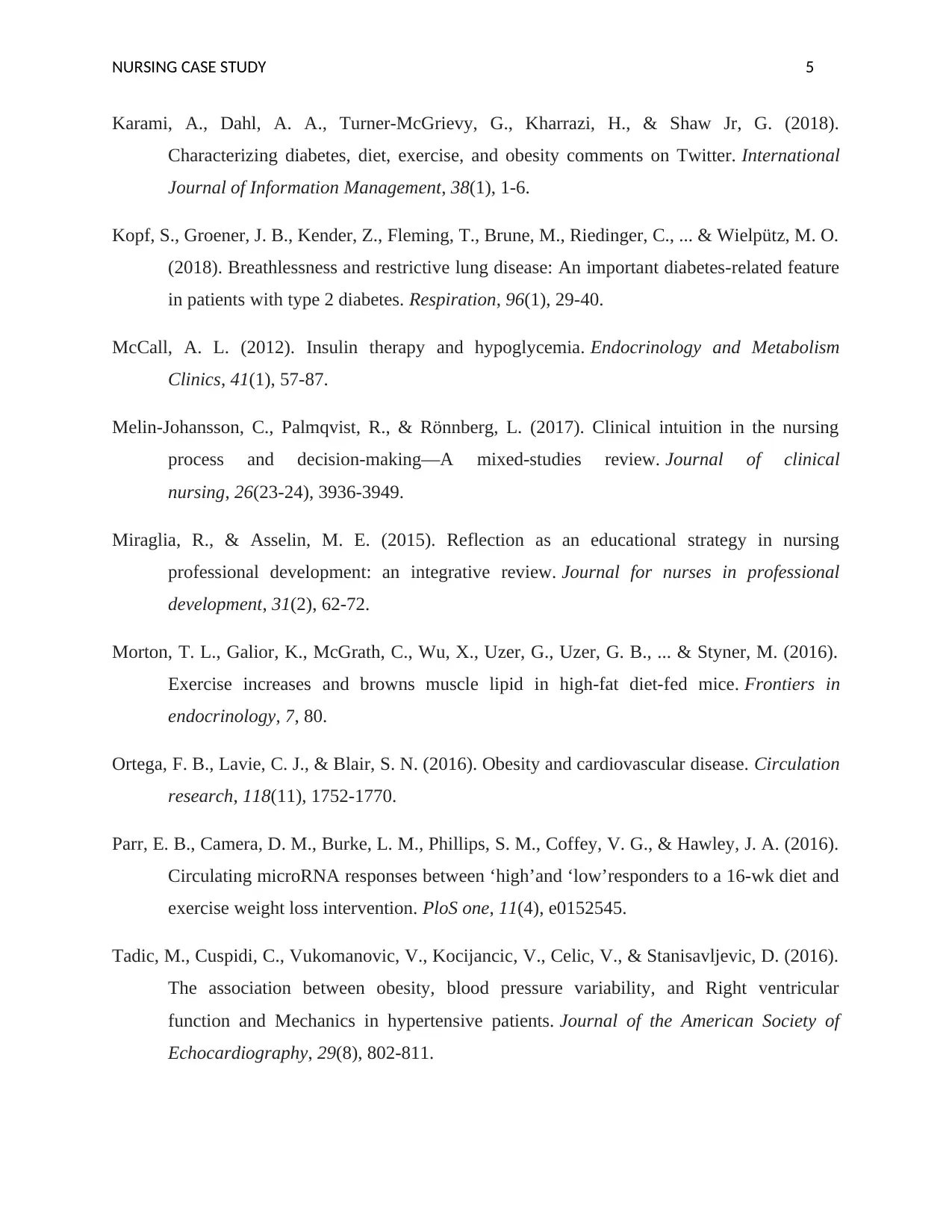
NURSING CASE STUDY 5
Karami, A., Dahl, A. A., Turner-McGrievy, G., Kharrazi, H., & Shaw Jr, G. (2018).
Characterizing diabetes, diet, exercise, and obesity comments on Twitter. International
Journal of Information Management, 38(1), 1-6.
Kopf, S., Groener, J. B., Kender, Z., Fleming, T., Brune, M., Riedinger, C., ... & Wielpütz, M. O.
(2018). Breathlessness and restrictive lung disease: An important diabetes-related feature
in patients with type 2 diabetes. Respiration, 96(1), 29-40.
McCall, A. L. (2012). Insulin therapy and hypoglycemia. Endocrinology and Metabolism
Clinics, 41(1), 57-87.
Melin‐Johansson, C., Palmqvist, R., & Rönnberg, L. (2017). Clinical intuition in the nursing
process and decision‐making—A mixed‐studies review. Journal of clinical
nursing, 26(23-24), 3936-3949.
Miraglia, R., & Asselin, M. E. (2015). Reflection as an educational strategy in nursing
professional development: an integrative review. Journal for nurses in professional
development, 31(2), 62-72.
Morton, T. L., Galior, K., McGrath, C., Wu, X., Uzer, G., Uzer, G. B., ... & Styner, M. (2016).
Exercise increases and browns muscle lipid in high-fat diet-fed mice. Frontiers in
endocrinology, 7, 80.
Ortega, F. B., Lavie, C. J., & Blair, S. N. (2016). Obesity and cardiovascular disease. Circulation
research, 118(11), 1752-1770.
Parr, E. B., Camera, D. M., Burke, L. M., Phillips, S. M., Coffey, V. G., & Hawley, J. A. (2016).
Circulating microRNA responses between ‘high’and ‘low’responders to a 16-wk diet and
exercise weight loss intervention. PloS one, 11(4), e0152545.
Tadic, M., Cuspidi, C., Vukomanovic, V., Kocijancic, V., Celic, V., & Stanisavljevic, D. (2016).
The association between obesity, blood pressure variability, and Right ventricular
function and Mechanics in hypertensive patients. Journal of the American Society of
Echocardiography, 29(8), 802-811.
Karami, A., Dahl, A. A., Turner-McGrievy, G., Kharrazi, H., & Shaw Jr, G. (2018).
Characterizing diabetes, diet, exercise, and obesity comments on Twitter. International
Journal of Information Management, 38(1), 1-6.
Kopf, S., Groener, J. B., Kender, Z., Fleming, T., Brune, M., Riedinger, C., ... & Wielpütz, M. O.
(2018). Breathlessness and restrictive lung disease: An important diabetes-related feature
in patients with type 2 diabetes. Respiration, 96(1), 29-40.
McCall, A. L. (2012). Insulin therapy and hypoglycemia. Endocrinology and Metabolism
Clinics, 41(1), 57-87.
Melin‐Johansson, C., Palmqvist, R., & Rönnberg, L. (2017). Clinical intuition in the nursing
process and decision‐making—A mixed‐studies review. Journal of clinical
nursing, 26(23-24), 3936-3949.
Miraglia, R., & Asselin, M. E. (2015). Reflection as an educational strategy in nursing
professional development: an integrative review. Journal for nurses in professional
development, 31(2), 62-72.
Morton, T. L., Galior, K., McGrath, C., Wu, X., Uzer, G., Uzer, G. B., ... & Styner, M. (2016).
Exercise increases and browns muscle lipid in high-fat diet-fed mice. Frontiers in
endocrinology, 7, 80.
Ortega, F. B., Lavie, C. J., & Blair, S. N. (2016). Obesity and cardiovascular disease. Circulation
research, 118(11), 1752-1770.
Parr, E. B., Camera, D. M., Burke, L. M., Phillips, S. M., Coffey, V. G., & Hawley, J. A. (2016).
Circulating microRNA responses between ‘high’and ‘low’responders to a 16-wk diet and
exercise weight loss intervention. PloS one, 11(4), e0152545.
Tadic, M., Cuspidi, C., Vukomanovic, V., Kocijancic, V., Celic, V., & Stanisavljevic, D. (2016).
The association between obesity, blood pressure variability, and Right ventricular
function and Mechanics in hypertensive patients. Journal of the American Society of
Echocardiography, 29(8), 802-811.
⊘ This is a preview!⊘
Do you want full access?
Subscribe today to unlock all pages.

Trusted by 1+ million students worldwide
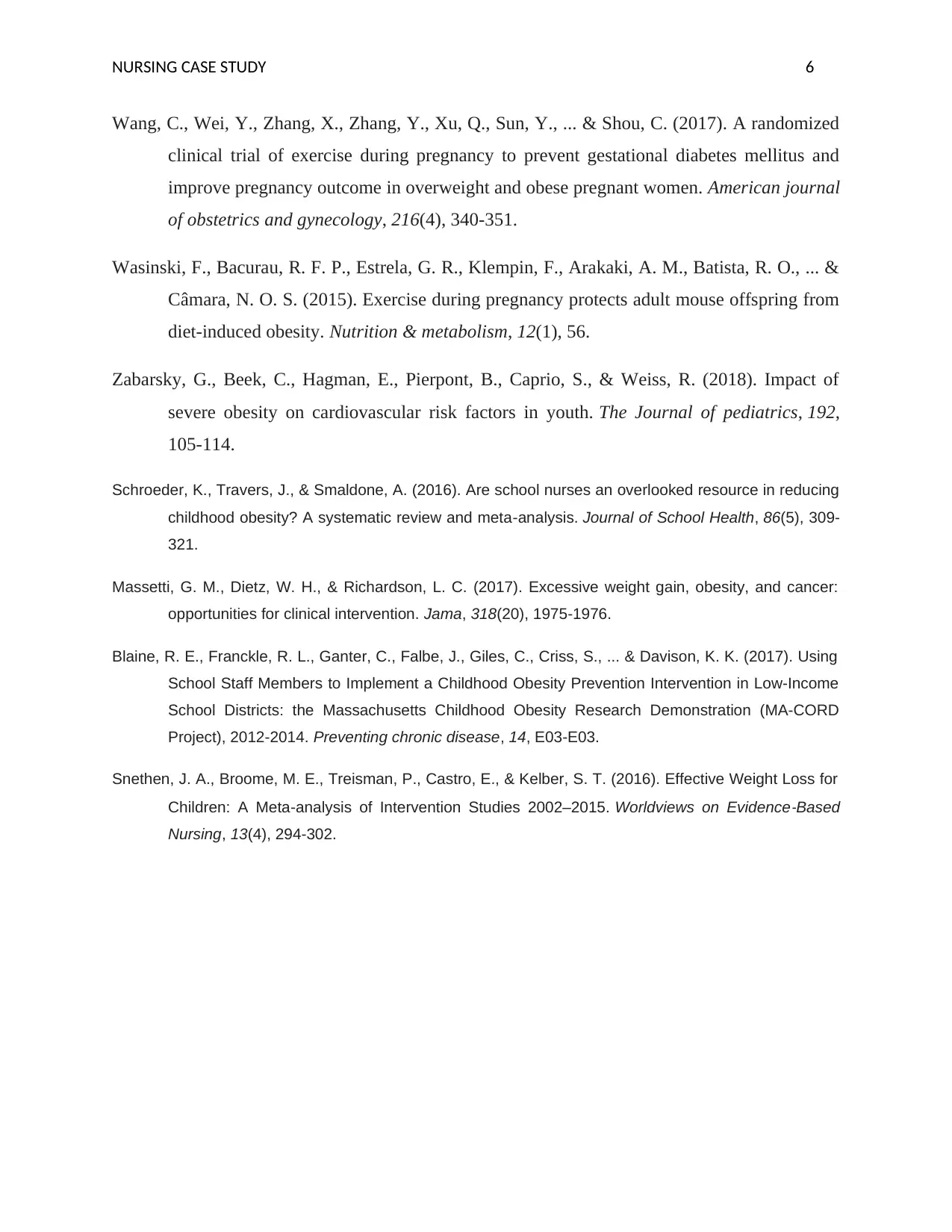
NURSING CASE STUDY 6
Wang, C., Wei, Y., Zhang, X., Zhang, Y., Xu, Q., Sun, Y., ... & Shou, C. (2017). A randomized
clinical trial of exercise during pregnancy to prevent gestational diabetes mellitus and
improve pregnancy outcome in overweight and obese pregnant women. American journal
of obstetrics and gynecology, 216(4), 340-351.
Wasinski, F., Bacurau, R. F. P., Estrela, G. R., Klempin, F., Arakaki, A. M., Batista, R. O., ... &
Câmara, N. O. S. (2015). Exercise during pregnancy protects adult mouse offspring from
diet-induced obesity. Nutrition & metabolism, 12(1), 56.
Zabarsky, G., Beek, C., Hagman, E., Pierpont, B., Caprio, S., & Weiss, R. (2018). Impact of
severe obesity on cardiovascular risk factors in youth. The Journal of pediatrics, 192,
105-114.
Schroeder, K., Travers, J., & Smaldone, A. (2016). Are school nurses an overlooked resource in reducing
childhood obesity? A systematic review and meta‐analysis. Journal of School Health, 86(5), 309-
321.
Massetti, G. M., Dietz, W. H., & Richardson, L. C. (2017). Excessive weight gain, obesity, and cancer:
opportunities for clinical intervention. Jama, 318(20), 1975-1976.
Blaine, R. E., Franckle, R. L., Ganter, C., Falbe, J., Giles, C., Criss, S., ... & Davison, K. K. (2017). Using
School Staff Members to Implement a Childhood Obesity Prevention Intervention in Low-Income
School Districts: the Massachusetts Childhood Obesity Research Demonstration (MA-CORD
Project), 2012-2014. Preventing chronic disease, 14, E03-E03.
Snethen, J. A., Broome, M. E., Treisman, P., Castro, E., & Kelber, S. T. (2016). Effective Weight Loss for
Children: A Meta‐analysis of Intervention Studies 2002–2015. Worldviews on Evidence
‐Based
Nursing, 13(4), 294-302.
Wang, C., Wei, Y., Zhang, X., Zhang, Y., Xu, Q., Sun, Y., ... & Shou, C. (2017). A randomized
clinical trial of exercise during pregnancy to prevent gestational diabetes mellitus and
improve pregnancy outcome in overweight and obese pregnant women. American journal
of obstetrics and gynecology, 216(4), 340-351.
Wasinski, F., Bacurau, R. F. P., Estrela, G. R., Klempin, F., Arakaki, A. M., Batista, R. O., ... &
Câmara, N. O. S. (2015). Exercise during pregnancy protects adult mouse offspring from
diet-induced obesity. Nutrition & metabolism, 12(1), 56.
Zabarsky, G., Beek, C., Hagman, E., Pierpont, B., Caprio, S., & Weiss, R. (2018). Impact of
severe obesity on cardiovascular risk factors in youth. The Journal of pediatrics, 192,
105-114.
Schroeder, K., Travers, J., & Smaldone, A. (2016). Are school nurses an overlooked resource in reducing
childhood obesity? A systematic review and meta‐analysis. Journal of School Health, 86(5), 309-
321.
Massetti, G. M., Dietz, W. H., & Richardson, L. C. (2017). Excessive weight gain, obesity, and cancer:
opportunities for clinical intervention. Jama, 318(20), 1975-1976.
Blaine, R. E., Franckle, R. L., Ganter, C., Falbe, J., Giles, C., Criss, S., ... & Davison, K. K. (2017). Using
School Staff Members to Implement a Childhood Obesity Prevention Intervention in Low-Income
School Districts: the Massachusetts Childhood Obesity Research Demonstration (MA-CORD
Project), 2012-2014. Preventing chronic disease, 14, E03-E03.
Snethen, J. A., Broome, M. E., Treisman, P., Castro, E., & Kelber, S. T. (2016). Effective Weight Loss for
Children: A Meta‐analysis of Intervention Studies 2002–2015. Worldviews on Evidence
‐Based
Nursing, 13(4), 294-302.
1 out of 7
Related Documents
Your All-in-One AI-Powered Toolkit for Academic Success.
+13062052269
info@desklib.com
Available 24*7 on WhatsApp / Email
![[object Object]](/_next/static/media/star-bottom.7253800d.svg)
Unlock your academic potential
Copyright © 2020–2025 A2Z Services. All Rights Reserved. Developed and managed by ZUCOL.





